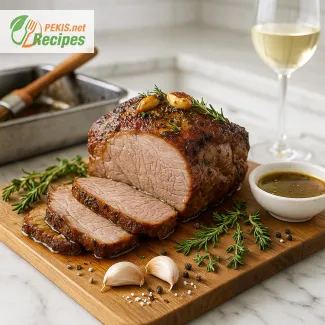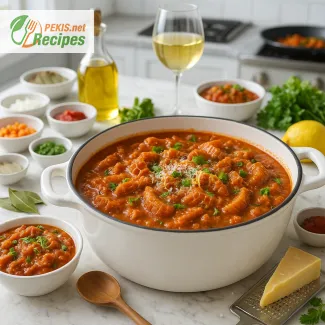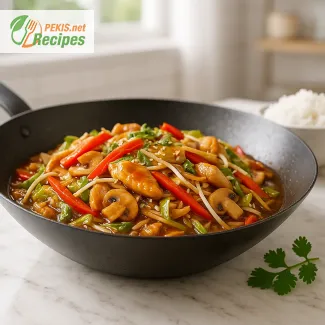
Discover the Timeless Charm of Königsberger Klopse
A beloved East Prussian delicacy brought to life in your kitchen
There are few traditional dishes that embody the comfort, history, and elegance of German cuisine as perfectly as Königsberger Klopse. These tender veal or beef meatballs, gently simmered and served in a creamy caper-infused white sauce, represent a culinary treasure from the former East Prussia, now part of modern-day Kaliningrad. Over generations, this dish has become a symbol of nostalgic home cooking throughout Germany, making its way onto family dinner tables, fine restaurant menus, and the hearts of food lovers who appreciate timeless, well-crafted meals.
With its unmistakable blend of tangy capers, smooth cream, and perfectly seasoned meatballs, Königsberger Klopse delivers a flavor profile that’s both comforting and refined. The contrast between the rich cream sauce and the slight bite of capers creates an unforgettable taste experience—one that lingers long after the last bite. While deeply rooted in tradition, the dish remains highly relevant today, offering a refreshing alternative to heavier, gravy-based meatball dishes found in other cuisines.
This recipe takes you step-by-step through the process of creating truly authentic Königsberger Klopse, ensuring that the flavors, textures, and aromas are preserved as they were intended. Whether you’re preparing it for a quiet family dinner or impressing guests with a classic European meal, this dish is guaranteed to evoke both warmth and sophistication.
The culinary heritage of Königsberger Klopse
Named after the historic city of Königsberg, once the capital of East Prussia, Königsberger Klopse have stood the test of time, despite political borders and cultural shifts. Traditionally made with finely ground veal, though modern recipes often use beef, pork, or a mix of both, the meatballs are delicately seasoned with onion, anchovy, pepper, and egg, then poached rather than fried to preserve their soft, almost velvety texture. The crowning glory, however, is the sauce—rich with butter, flour, stock, egg yolk, lemon juice, and most importantly, capers.
While many meatball recipes around the world focus on bold, spicy flavors or tomato-based sauces, Königsberger Klopse stands out for its subtlety and nuance. This dish is a celebration of balance: the slight acidity of the capers and lemon juice cuts through the richness of the sauce, while the meatballs provide a comforting base that absorbs and enhances these flavors.
Why this dish deserves a spot on your table
Whether you’re discovering this recipe for the first time or reviving a cherished family tradition, Königsberger Klopse offers a unique fusion of rustic charm and culinary finesse. It brings a taste of European history into the modern home kitchen, offering not just a meal, but a story on a plate. The process of making it—from shaping the meatballs by hand to gently whisking the creamy sauce—invites a slower, more mindful way of cooking, one that rewards patience with depth of flavor.
This dish also pairs beautifully with a variety of side dishes, from boiled potatoes and buttered rice to steamed vegetables and pickled beets, allowing you to tailor it to your own preferences or dietary needs. Whether you keep it traditional or add your own modern twist, this recipe is sure to win hearts and satisfy cravings.
The perfect comfort food for any season
Although Königsberger Klopse is often thought of as a cozy winter dish, its bright and creamy sauce also makes it suitable for lighter, springtime meals. Unlike heavier stews, the lemon and caper components lend a refreshing quality that balances the richness, making it an ideal recipe for year-round enjoyment. It’s equally fitting for festive gatherings, quiet dinners, or when you're simply in need of some honest, soul-soothing food.
This versatile and deeply satisfying recipe will not only transport your taste buds to the heart of East Prussia but also expand your culinary repertoire with a dish that’s as elegant as it is approachable. Whether you serve it to curious friends eager to try something new or enjoy it solo with a glass of crisp white wine, Königsberger Klopse is a dish that quietly, yet confidently, steals the show.
1. Prepare the meatballs (Klopse):
Finely dice the onion. In a small pan, melt the butter and gently sauté the onion until translucent, about 5 minutes. Let it cool. Soak the bread in milk for 10 minutes, then squeeze out the excess liquid and crumble it into a large mixing bowl.
Add the ground meat, eggs, chopped anchovies, sautéed onions, salt, and pepper. Mix well with your hands until all ingredients are fully incorporated and the mixture is smooth. Form 12 equal-sized meatballs.
2. Poach the meatballs:
In a large pot, bring 1 liter of water to a gentle simmer. Add bay leaves and allspice berries. Carefully place the meatballs into the simmering water (do not boil) and let them cook gently for 20 minutes until firm. Remove the meatballs with a slotted spoon and reserve 500 ml (2 cups) of the cooking liquid for the sauce.
3. Prepare the caper sauce:
In a medium saucepan, melt the butter. Add flour and stir constantly to form a smooth roux. Cook for 1–2 minutes without browning. Gradually whisk in the reserved cooking liquid to avoid lumps. Bring the sauce to a gentle simmer and cook for about 5–7 minutes until thickened.
In a separate bowl, whisk together the heavy cream and egg yolks. Slowly stir this mixture into the sauce off the heat to prevent curdling. Add lemon juice, drained capers, salt, and pepper. Stir to combine and return briefly to low heat if needed, without boiling.
4. Assemble the dish:
Place the poached meatballs in the sauce and gently warm them through for about 5 minutes. Serve immediately with boiled potatoes or steamed rice.
Creative Enhancements for Königsberger Klopse at Home
Innovative ideas to elevate this classic German comfort dish
Königsberger Klopse is a dish steeped in tradition and nostalgia, but like all classic recipes, it also offers room for personalization and culinary creativity. While the original recipe—tender meatballs served in a creamy caper sauce—is a masterclass in balance and subtle flavor, even small adjustments can yield exciting and delicious variations. By experimenting with different ingredients, techniques, or serving methods, home cooks can craft a version that suits their tastes while still respecting the dish’s rich heritage.
Ingredient upgrades that enhance flavor and texture
Changing or supplementing certain ingredients in the recipe can profoundly impact the taste, texture, and nutritional value of Königsberger Klopse.
Use higher-quality meat or blend meats for complexity
Traditional recipes often use veal, which offers a delicate flavor and tender texture. However, blending veal with pork or even beef and lamb can add complexity and richness. Using organic or grass-fed meat not only improves flavor but also contributes to a more sustainable dish. For a lighter option, ground turkey or chicken can be substituted, though they may yield a slightly firmer texture.
Enhance umami with additional depth
While anchovies already add umami, introducing a touch of grated Parmesan or a few drops of Worcestershire sauce can deepen the savory notes without overwhelming the original profile. These ingredients blend harmoniously into the meat mixture or sauce and bring out the flavors of other components.
Add texture and aroma to the sauce
The creamy caper sauce is the heart of the dish, and small enhancements can make it even more memorable. Adding a dash of dry white wine while deglazing the roux introduces acidity and aromatic complexity. Infusing the sauce with a hint of freshly grated nutmeg or a few crushed juniper berries can tie the flavors together beautifully, evoking the forested essence of northern European cuisine.
Why homemade Königsberger Klopse always tastes better
Preparing this dish from scratch allows for full control over ingredients and technique, resulting in a meal that is richer, fresher, and more flavorful than many restaurant or pre-packaged versions. Homemade Klopse tend to be more tender and better seasoned because the cook can adjust proportions and cooking times precisely. Furthermore, freshly made sauces are less likely to contain additives or preservatives, making the dish not only tastier but also healthier.
Common mistakes and how to avoid them
Even experienced cooks can make small errors when preparing Königsberger Klopse. Recognizing these potential pitfalls is key to mastering the dish.
Overcooking the meatballs
One of the most frequent mistakes is boiling the meatballs too vigorously, which can lead to a rubbery texture and broken shape. The poaching liquid should remain just below boiling—a gentle simmer is ideal. This ensures that the meatballs stay tender and intact.
Skipping the anchovies
While some may omit anchovies due to dietary preferences, doing so removes a critical source of depth and umami. If avoiding fish, try finely chopped olives or fermented miso paste as a plant-based substitute.
Rushing the sauce
Cream sauces require gentle and slow cooking to maintain a smooth consistency and avoid curdling. Introducing egg yolks must be done carefully, off the heat, and always with gradual tempering to prevent scrambling.
Healthier variations for conscious eaters
Though this dish is rich and comforting by nature, several adjustments can make it more suitable for a health-conscious diet without sacrificing flavor.
Lower-fat dairy alternatives
Replace heavy cream with low-fat crème fraîche, Greek yogurt, or plant-based cream alternatives. These swaps reduce saturated fat while preserving the sauce’s creaminess. Always introduce yogurt off the heat to avoid separation.
Whole grain or gluten-free bread
Substitute white bread with whole grain, rye, or gluten-free bread to increase fiber content and cater to gluten-sensitive individuals. Ensure the bread is still soft enough to break down smoothly into the meat mixture.
Reduce sodium without losing flavor
Instead of relying heavily on salt, enhance flavor using herbs like parsley, chives, or marjoram, and acidic elements like lemon juice or a splash of vinegar. These ingredients brighten the dish and reduce the need for excess seasoning.
New serving ideas that make an impression
Although traditionally served with boiled potatoes, Königsberger Klopse can also shine when paired with:
- Cauliflower mash – for a low-carb option
- Buttered spaetzle – a German twist on pasta
- Braised red cabbage – for contrast in texture and sweetness
- Crusty sourdough bread – ideal for soaking up sauce
Serving the dish in a shallow bowl with garnished parsley, a drizzle of sauce, and bright pickled vegetables on the side elevates the presentation, turning a rustic meal into an elegant centerpiece.
Preserving the soul while embracing evolution
What makes Königsberger Klopse truly special is its harmonious balance—the creamy, the tangy, the savory. Every adjustment should honor this foundation. By focusing on quality ingredients, proper technique, and thoughtful personalization, the dish remains true to its roots while reflecting the cook’s creativity. Whether preparing it for the first time or the fiftieth, Königsberger Klopse can always evolve—improving with each new touch of care, flavor, and intention.
Allergens present in this recipe:
- Gluten (wheat flour, bread)
- Eggs
- Dairy (milk, butter, cream)
- Fish (anchovies)
Substitution tips to make the recipe allergy-friendly and gluten-free:
- Replace white bread with gluten-free bread
- Use gluten-free flour in the sauce
- Substitute dairy milk and cream with oat or soy alternatives
- Omit anchovies or replace with finely chopped seaweed for umami
- Vitamin A: 450 µg – supports vision and immune system
- Vitamin B12: 1.5 µg – essential for nerve function and red blood cells
- Vitamin D: 1.2 µg – contributes to bone health
- Calcium: 110 mg – strengthens bones and teeth
- Iron: 3.2 mg – supports oxygen transport in blood
- Zinc: 4.5 mg – boosts immunity and healing
- Selenium: 25 µg – protects cells from oxidative stress
- Vitamin E: 2.4 mg – supports skin health and protects cells
- Lutein: 0.3 mg – promotes eye health
- Glutathione (from veal and onions): medium content – supports liver detoxification





